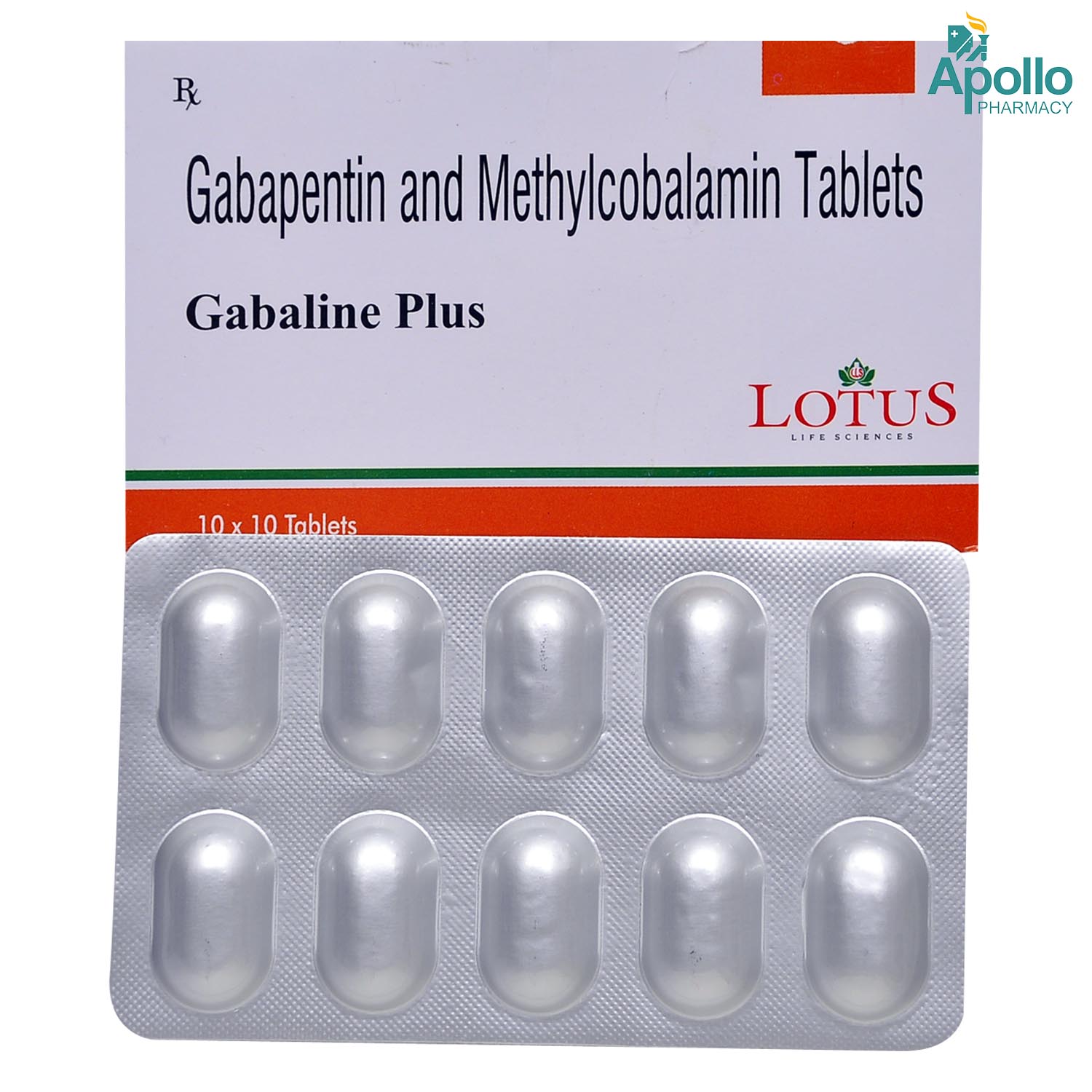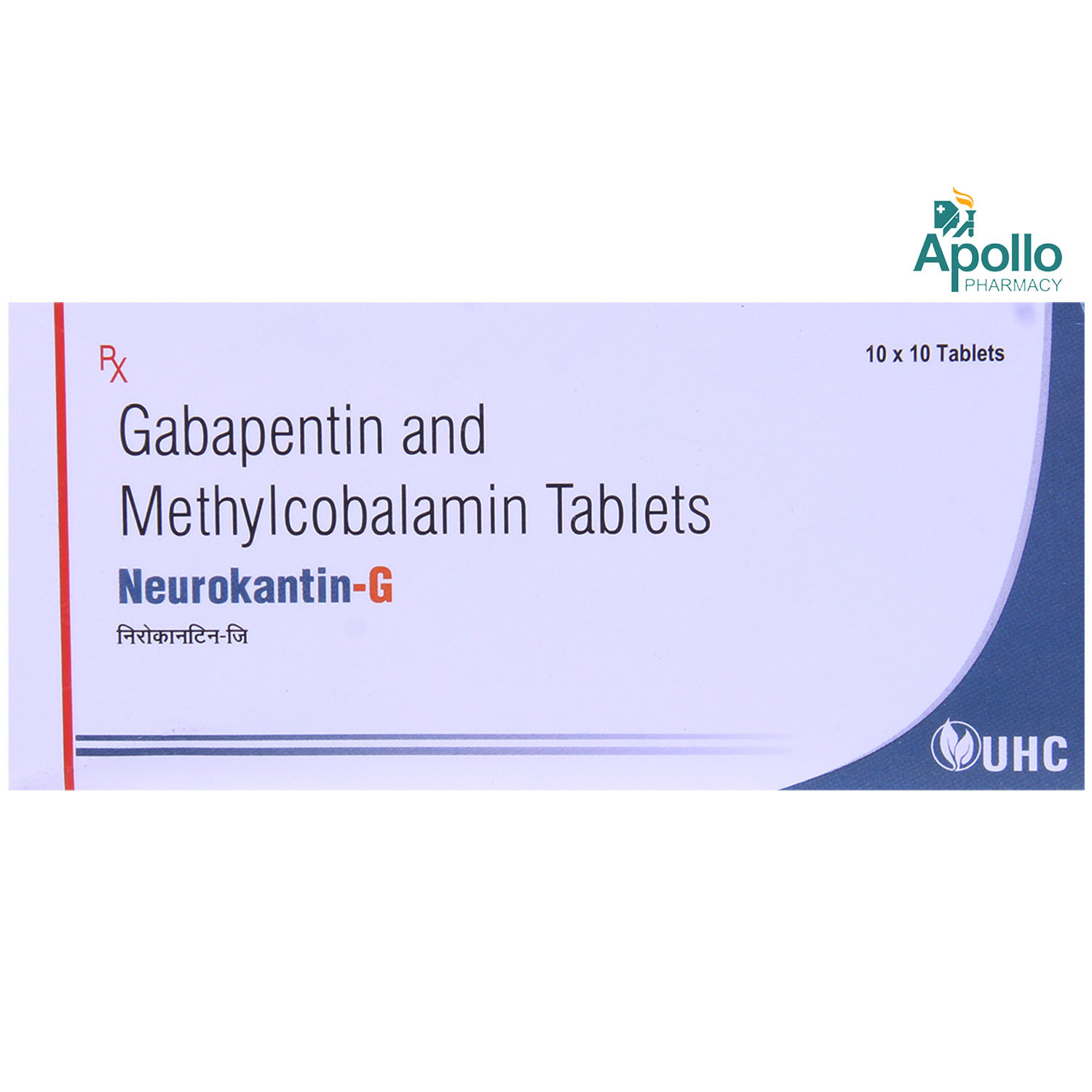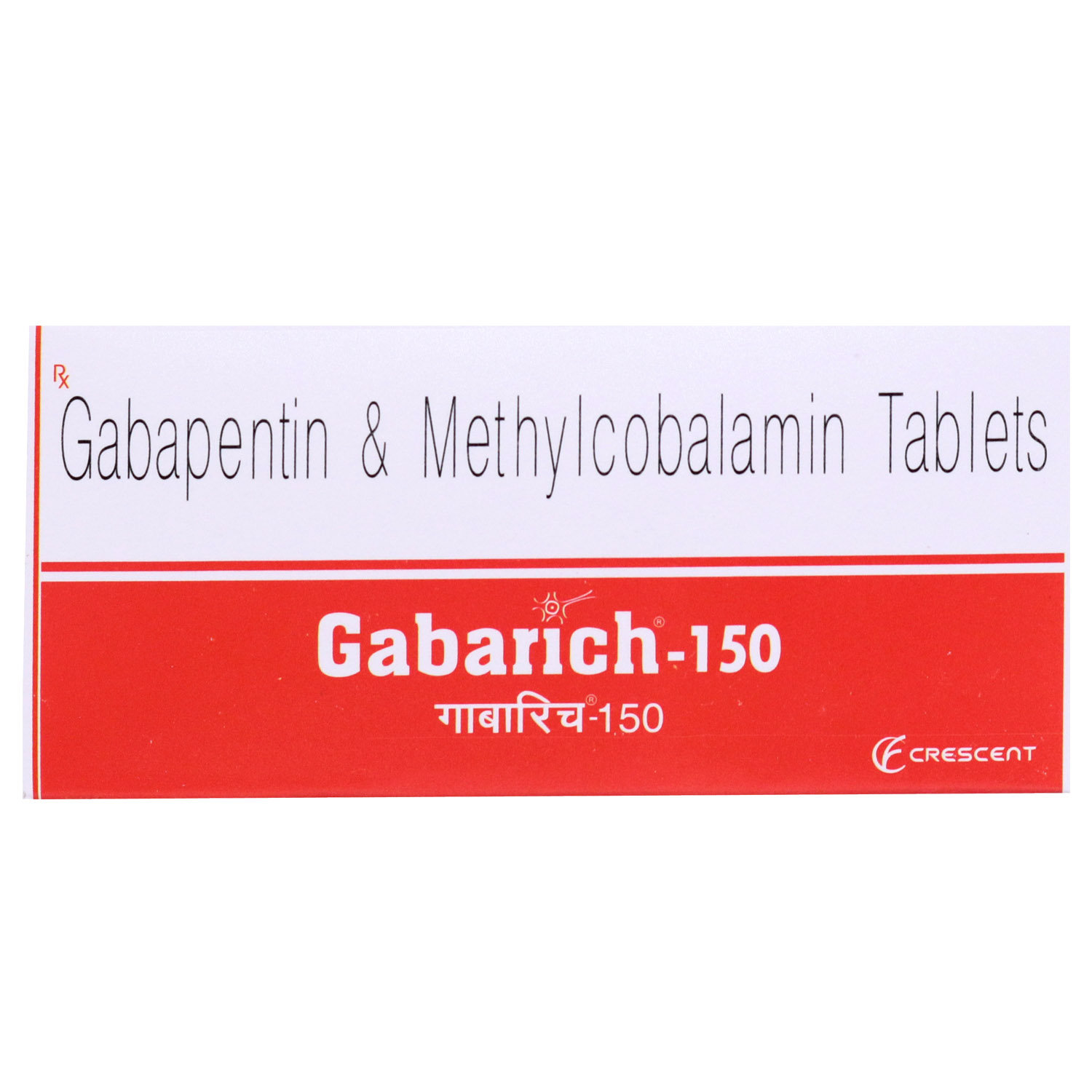Gabafame-150 Tablet 10's


MRP ₹134.5
(Inclusive of all Taxes)
₹20.2 Cashback (15%)
Provide Delivery Location
Online payment accepted
 Prescription drug
Prescription drugWhats That
Composition :
Manufacturer/Marketer :
Consume Type :
Return Policy :
About Gabafame-150 Tablet 10's
Gabafame-150 Tablet 10's belongs to a class of 'anticonvulsants,' primarily used to treat partial seizures (epilepsy) and various conditions of nerve pain/damage like post-herpetic neuralgia. Epilepsy is a neurological condition in which the brain's activity becomes abnormal with seizures episodes, sometimes losing awareness or consciousness. Neuralgia is a chronic pain condition of the nerves that occurs due to nerve damage or other neurological conditions like neuropathy, trigeminal neuralgia or shingles.
Gabafame-150 Tablet 10's consists of two drugs: Gabapentin (anticonvulsant) and Methylcobalamin (Mecobalamin or vitamin B12). Gabapentin treats seizures or fits by balancing chemical messengers (neurotransmitters) in the brain, furtherly reducing their abnormal excitement in the brain. Methylcobalamin is a coenzyme form of vitamin B12. It rejuvenates and protects damaged nerve cells by producing a substance called myelin. It also regulates body functions, such as cell multiplication, blood formation, and protein synthesis. Together, Gabafame-150 Tablet 10's helps provide relief from neuropathic pain caused due to nerve damage and other neurological disorders.
Your doctor will decide the dosage and duration based on your medical condition. Sometimes, Gabafame-150 Tablet 10's may have common side effects like dizziness, sleepiness, tiredness, nausea and vomiting. These side effects do not require medical attention and gradually resolve over time. However, you are advised to talk to your doctor if you experience these side effects for a longer duration.
Let your doctor know if you are using any prescription, non-prescription drugs, and herbal products before starting Gabafame-150 Tablet 10's. If you are a pregnant or breastfeeding mother, please consult your doctor before taking Gabafame-150 Tablet 10's. Gabafame-150 Tablet 10's causes drowsiness and dizziness, so drive only if you are alert. Gabafame-150 Tablet 10's should not be given to children under three years as safety and effectiveness have not been established. Avoid consuming alcohol along with Gabafame-150 Tablet 10's as it could lead to increased dizziness and sleepiness.
Uses of Gabafame-150 Tablet 10's
Directions for Use
Medicinal Benefits
Gabafame-150 Tablet 10's is used to treat post-herpetic neuralgia and epilepsy. It contains Gabapentin (anti-convulsant) and Methylcobalamin (Mecobalamin or vitamin B12). Gabapentin works by binding to the specific site on voltage-gated calcium channels; this helps relieve nerve pain and lowers the risk of seizures. Methylcobalamin helps in the rejuvenation and protection of damaged nerve cells by producing a substance called myelin. It is also used to treat alcoholic neuropathy and diabetic neuropathy (nerve damage due to high blood sugar levels).
Storage
- Inform your doctor about dizziness symptoms. They may adjust your medication regimen or prescribe additional medications to manage symptoms.
- Follow your doctor's instructions for taking medication, and take it at the same time every day to minimize dizziness.
- When standing up, do so slowly and carefully to avoid sudden dizziness.
- Avoid making sudden movements, such as turning or bending quickly, which can exacerbate dizziness.
- Drink plenty of water throughout the day to stay hydrated and help alleviate dizziness symptoms.
- If you're feeling dizzy, sit or lie down and rest until the dizziness passes.
- Track when dizziness occurs and any factors that may trigger it, and share this information with your doctor to help manage symptoms.
- Rest well; get enough sleep.
- Eat a balanced diet and drink enough water.
- Manage stress with yoga and meditation.
- Limit alcohol and caffeine.
- Physical activities like walking or jogging might help boost energy and make you feel less tired.
Drug Warnings
Inform your doctor before taking Gabafame-150 Tablet 10's if you have a medical history of heart problems, bipolar syndrome, and nervous system disorders. Consult your doctor if you are on haemodialysis and experience muscle pain or weakness, persistent stomach pain, nausea, and vomiting. Please do not stop taking Gabafame-150 Tablet 10's without consulting your doctor as it could cause withdrawal symptoms. Pregnant and breastfeeding women should consult their doctor before taking Gabafame-150 Tablet 10's. Consult your doctor immediately if you experience suicidal tendencies. Keep Gabafame-150 Tablet 10's away from direct sunlight. Do not store Gabafame-150 Tablet 10's above 25ºC and keep it away from direct sunlight.
Drug-Drug Interactions
Drug-Drug Interactions
Login/Sign Up
Combining Gabafame-150 Tablet with Esketamine can increase the risk of side effects.
How to manage the interaction:
Although taking Gabafame-150 Tablet and Esketamine together can evidently cause an interaction, it can be taken if a doctor has suggested it. Consult a doctor if you experience any symptoms such as drowsiness, confusion, difficulty concentrating, and impairment in thinking, judgment, reaction speed, and motor coordination. Do not stop using any medications without a doctor's advice.
Taking fentanyl with other drugs that cause central nervous system depression, such as Gabafame-150 Tablet, might result in an increased risk of adverse effects.
How to manage the interaction:
Although combining Fentanyl and Gabafame-150 Tablet may cause an interaction, they can be used if advised by your doctor. Consult your doctor immediately if you feel drowsiness, trouble breathing, dizziness, or confusion. If you have any of the above symptoms, it is advised not to drive or use any hazardous machinery. Do not stop taking any medication without consulting your doctor.
Combining Meperidine with Gabafame-150 Tablet can increase the risk of CNS depression.
How to manage the interaction:
Co-administration of Pethidine with Gabafame-150 Tablet can possibly result in an interaction, but it can be taken if a doctor has advised it. Do not stop using any medications without a doctor's advice.
Combining Remifentanil with Gabafame-150 Tablet can increase the risk of side effects.
How to manage the interaction:
Taking Gabafame-150 Tablet with Remifentanil together can possibly result in an interaction, but it can be taken if a doctor has advised it. If you notice any symptoms like trouble breathing, dizziness, or trouble focusing, make sure to contact a doctor right away. Do not discontinue any medications without consulting a doctor.
Co-administration of Buprenorphine and Gabafame-150 Tablet may cause central nervous system depression and lead to serious side effects (respiratory distress -build-up of fluid in the air sacs of the lungs).
How to manage the interaction:
Although there is a possible interaction between Gabafame-150 Tablet and Buprenorphine, you can take these medicines together if prescribed by a doctor. However, if you experience shortness of breath, fast heart rate, fast breathing, extreme tiredness, fever, cough with phlegm, or shallow breaths, consult the doctor immediately. Do not discontinue any medications without a doctor's advice.
Combining Sufentanil with Gabafame-150 Tablet can increase the risk of CNS depression.
How to manage the interaction:
There may be a possibility of interaction between Gabafame-150 Tablet and Sufentanil, but it can be taken if prescribed by a doctor. It's important to keep an eye on your health and talk to a doctor about any concerns. They can recommend different options that won't cause any problems. If you notice any symptoms like trouble breathing, feeling dizzy or tired, or having trouble focusing, make sure to call your doctor right away. Do not discontinue any medications without first consulting your doctor.
Co-administration of Methadone and Gabafame-150 Tablet may cause central nervous system depression and lead to serious side effects such as respiratory distress (build-up of fluid in the air sacs of the lungs).
How to manage the interaction:
Although there is a possible interaction between Gabafame-150 Tablet and Methadone, you can take these medicines together if prescribed by a doctor. However, if you experience shortness of breath, fast heart rate, fast breathing, extreme tiredness, fever, cough with phlegm, or shallow breaths, please consult your doctor immediately. Do not discontinue any medications without a doctor's advice.
Taking Gabafame-150 Tablet with Sodium oxybate can increase the side effects on the central nervous system.
How to manage the interaction:
Although taking Gabafame-150 Tablet and Sodium oxybate together can evidently cause an interaction, it can be taken if a doctor has suggested it. If you notice any of these signs - feeling tired, dizzy, lightheaded, confused, sad, having low blood pressure, or difficulty breathing - make sure to contact your doctor right away. Do not stop using any medications without talking to a doctor.
Co-administration of Butorphanol and Gabafame-150 Tablet may cause central nervous system depression and lead to serious side effects such as respiratory distress (build-up of fluid in the air sacs of the lungs).
How to manage the interaction:
Although there is a possible interaction between Gabafame-150 Tablet and Butorphanol, you can take these medicines together if prescribed by a doctor. However, if you experience shortness of breath, fast heart rate, fast breathing, extreme tiredness, fever, cough with phlegm, or shallow breaths, please consult a doctor immediately. Do not discontinue any medications without a doctor's advice.
When Hydrocodone is taken with Gabafame-150 Tablet, the amount of Hydrocodone in the blood may be reduced.
How to manage the interaction:
Although there is a possible interaction between Gabafame-150 Tablet and Hydrocodone, you can take these medicines together if prescribed by a doctor. If you notice any symptoms like trouble breathing, dizziness, or trouble focusing, make sure to contact a doctor right away. Do not stop using any medications without a doctor's advice.
Drug-Food Interactions
Drug-Food Interactions
Login/Sign Up
Diet & Lifestyle Advise
- Include food rich in vitamin B and D in your diet as they can help in improving nerve health and preventing nerve pain.
- Include cayenne pepper in your diet as it can help in lowering neuropathic pain.
- Exercising regularly helps in improving overall health and combating pain.
- Rest well; get plenty of sleep.
- Try taking a warm bath as it can be soothing. It helps in increasing blood circulation, thereby decreases numbness and pain.
- Avoid smoking and alcohol consumption.
- Meditation and yoga can help lower stress, decrease pain sensitivity and improves coping skills.
- Physical relaxation and massages can help provide symptomatic relief.
- Learn about techniques for sitting, stretching, moving, and standing from a physical or occupational therapist. These can help prevent pain.
- Acupuncture can be helpful by stimulating pressure points.
- Using essential oils for massages can help increase circulation and boosts healing.
Side Effects of Gabafame-150 Tablet 10's
- Dizziness
- Sleepiness
- Tiredness
- Nausea
- Vomiting
Habit Forming
Therapeutic Class
All Substitutes & Brand Comparisons
RX
Out of StockMaxcio-G Tablet
₹106.45
(₹9.58 per unit)
28% CHEAPERRX
Gabaline Plus Tablet 10's
Lotus Life Sciences
₹147
(₹13.23 per unit)
1% CHEAPERRX
Neurokantin-G Tablet 10's
Uhc Remedies
₹158
(₹14.22 per unit)
5% COSTLIER
Product Substitutes
Author Details
We provide you with authentic, trustworthy and relevant information
Drug-Diseases Interactions
Drug-Diseases Interactions
Login/Sign Up
FAQs
Gabafame-150 Tablet 10's works by controlling the abnormal electrical activity of the brain that causes seizures (fits). It also helps in the rejuvenation and protection of damaged nerve cells.
Gabafame-150 Tablet 10's may cause weight gain due to an increase in appetite. Maintain a healthy weight by regular exercise and following a balanced diet.
People taking Gabafame-150 Tablet 10's should be closely monitored for suicidal thoughts or behaviour. Do not be reluctant to speak with your doctor immediately if you experience suicidal tendencies.
If Gabafame-150 Tablet 10's is taken along with antacid medicines containing aluminium and magnesium, it may lower the absorption of Gabafame-150 Tablet 10's from the stomach. To avoid this, maintain a gap of two hours between Gabafame-150 Tablet 10's and antacid medicines.
If you miss a dose, take it as soon as you remember. However, if it is time for the next scheduled dose, skip the missed dose and follow your usual dosage.
Drug-Drug Interactions Checker List
- HYDROCODONE
- ACETAMINOPHEN
- DULOXETINE
- ESCITALOPRAM
- SERTRALINE
- CYCLOBENZAPRINE
- ALPRAZOLAM
- PREGABALIN
- QUETIAPINE
- CHLORAMPHENICOL
- METFORMIN
Special Advise
- Close monitoring for suicidal thoughts/behaviour is required in people using Gabafame-150 Tablet 10's.
- Using Gabafame-150 Tablet 10's in children 3-12 years of age can cause emotional changes, aggressive behaviour, concentration problems, restlessness, school performance changes, and hyperactivity.
- Let your doctor and the laboratory staff know if you are using Gabafame-150 Tablet 10's since Gabapentin may interfere with laboratory tests.
Disease/Condition Glossary
Epilepsy is the central nervous system's disorder in which brain activity becomes abnormal, leading to rapid fits/seizures episodes with unusual behaviour and loss of awareness. Fits/Seizure is a sudden rush of electrical activity in the brain. The main symptom of epilepsy fits.
Neuropathic pain: It is a nervous system disorder caused due to damage to sensory nerves. It is caused by chronic progressive nerve disease or due to infection or injury. The pain could be intermittent or continuous, which is felt as a prickling, stabbing, tingling or burning sensation. A feeling of numbness and loss of sensations is also common with neuropathic pain. Usually, the body sends the pain signals when there is an injury, but with neuropathic pain, the pain is not triggered by an injury; the body unpromptedly sends the pain signals. Symptoms include spontaneous, untriggered pain, unpleasant feeling, shooting, burning or stabbing pain, difficulty resting or sleeping, and evoked pain (pain caused by events that are usually not painful).

Have a query?
Buy best C.n.s Drugs products by
Intas Pharmaceuticals Ltd
Sun Pharmaceutical Industries Ltd
Torrent Pharmaceuticals Ltd
Alkem Laboratories Ltd
Abbott India Ltd
Cipla Ltd
Alteus Biogenics Pvt Ltd
Micro Labs Ltd
Lupin Ltd
Ipca Laboratories Ltd
D D Pharmaceuticals Pvt Ltd
Icon Life Sciences
Mankind Pharma Pvt Ltd
Tripada Healthcare Pvt Ltd
Arinna Lifesciences Ltd
Linux Laboratories Pvt Ltd
East West Pharma India Pvt Ltd
La Renon Healthcare Pvt Ltd
Talent India Pvt Ltd
Tas Med India Pvt Ltd
Zydus Healthcare Ltd
Cnx Health Care Pvt Ltd
Eris Life Sciences Ltd
Leeford Healthcare Ltd
Emcure Pharmaceuticals Ltd
Macleods Pharmaceuticals Ltd
Sigmund Promedica
Aristo Pharmaceuticals Pvt Ltd
Dr Reddy's Laboratories Ltd
Troikaa Pharmaceuticals Ltd
Consern Pharma Ltd
Zydus Cadila
Shine Pharmaceuticals Ltd
Wockhardt Ltd
Ardent Life Sciences Pvt Ltd
Crescent Formulations Pvt Ltd
Theo Pharma Pvt Ltd
Reliance Formulation Pvt Ltd
Ikon Pharmaceuticals Pvt Ltd
Propel Healthcare
Neon Laboratories Ltd
Jagsam Pharma
Msn Laboratories Pvt Ltd
Morepen Laboratories Ltd
Pulse Pharmaceuticals
Sanofi India Ltd
Med Manor Organics Pvt Ltd
Hetero Healthcare Pvt Ltd
Novartis India Ltd
Crescent Therapeutics Ltd
Elder Pharmaceuticals Ltd
Solvate Laboratories Pvt Ltd
Akumentis Healthcare Ltd
Mova Pharmaceutical Pvt Ltd
Psyco Remedies Ltd
Tripada Lifecare Pvt Ltd
Ajanta Pharma Ltd
Cyrus Remedies Pvt Ltd
Medishri Healthcare Pvt Ltd
Cadila Healthcare Ltd
Glenmark Pharmaceuticals Ltd
Matteo Health Care Pvt Ltd
Hbc Life Sciences Pvt Ltd
Lyf Healthcare
Matias Healthcare Pvt Ltd
Mesmer Pharmaceuticals
Alembic Pharmaceuticals Ltd
Capital Pharma
Crescent Pharmaceuticals
Medopharm Pvt Ltd
Alniche Life Sciences Pvt Ltd
Kivi Labs Ltd
Talin Remedies Pvt Ltd
USV Pvt Ltd
Quince Lifesciences Pvt Ltd
Solis Pharmaceuticals
Infivis Life Care
Zuventus Healthcare Ltd
Cadila Pharmaceuticals Ltd
Pfizer Ltd
Wallace Pharmaceuticals Pvt Ltd
A N Pharmacia Laboratories Pvt Ltd
Blue Cross Laboratories Pvt Ltd
Jenburkt Pharmaceuticals Ltd
Lia Life Sciences Pvt Ltd
Mano Pharma
Medley Pharmaceuticals Ltd
Primus Remedies Pvt Ltd
FDC Ltd
Maneesh Pharmaceuticals Ltd
Apex Laboratories Pvt Ltd
Gagnant Healthcare Pvt Ltd
Ozone Pharmaceuticals Ltd
RPG Life Sciences Ltd
Strides Shasun Ltd
Unichem International
GlaxoSmithKline Pharmaceuticals Ltd
Kuresys Labs Pvt Ltd
LA Pharma
Trion Pharma India Llp
Alcohol
Unsafe
Avoid consumption of alcohol while taking Gabafame-150 Tablet 10's as it may increase dizziness and sleepiness.
Pregnancy
Caution
Gabafame-150 Tablet 10's is not recommended during pregnancy unless prescribed by a doctor. Let your doctor know if you are pregnant or planning to conceive before taking Gabafame-150 Tablet 10's.
Breast Feeding
Caution
Gabapentin in Gabafame-150 Tablet 10's is excreted into breast milk. Please consult your doctor before taking Gabafame-150 Tablet 10's if you are breastfeeding.
Driving
Unsafe
Gabafame-150 Tablet 10's causes drowsiness, sleepiness and tiredness. Do not drive or operate machinery unless you are mentally and physically alert.
Liver
Caution
Let your doctor know if you have any history of liver diseases before taking Gabafame-150 Tablet 10's. Dose adjustment may be needed in patients with liver impairment.
Kidney
Caution
Let your doctor know if you have any history of kidney diseases before taking Gabafame-150 Tablet 10's. Dose adjustment may be needed in patients with kidney impairment.
Children
Caution
Gabafame-150 Tablet 10's is not recommended in children less than three years of age. The doctor will prescribe the dosage of Gabafame-150 Tablet 10's based on the child's age and weight.








